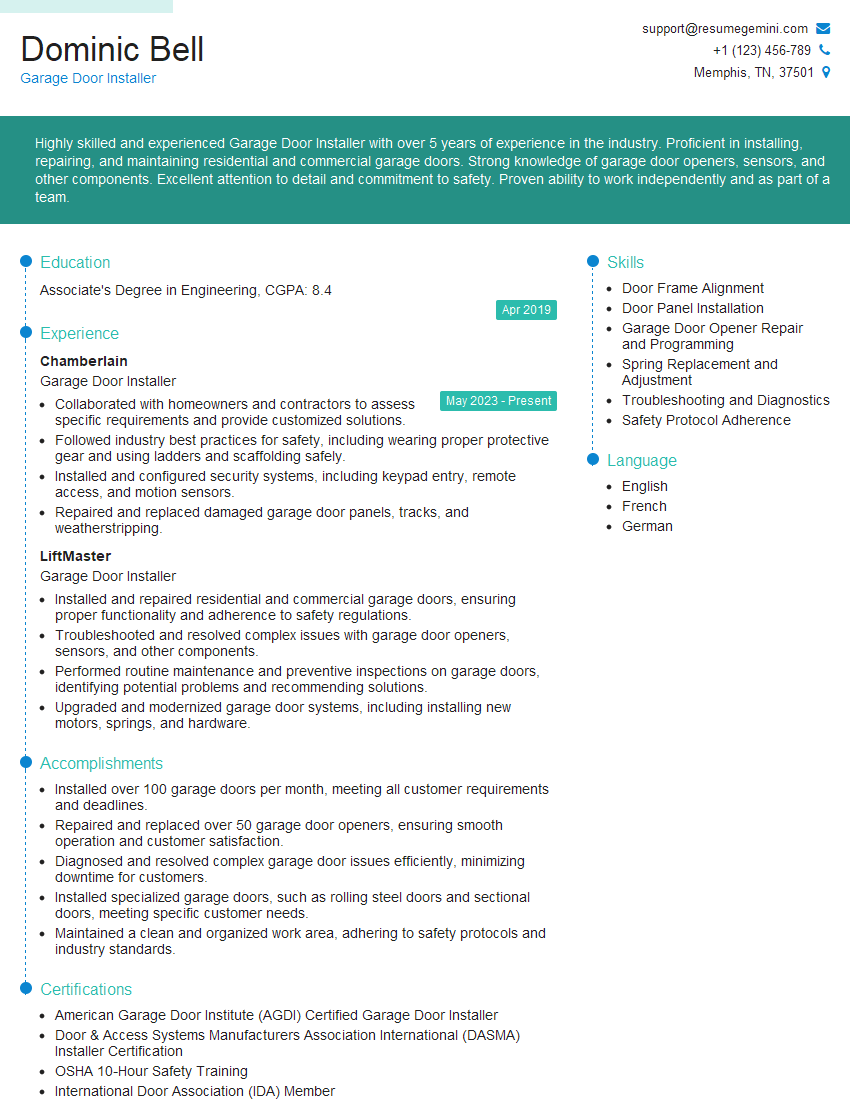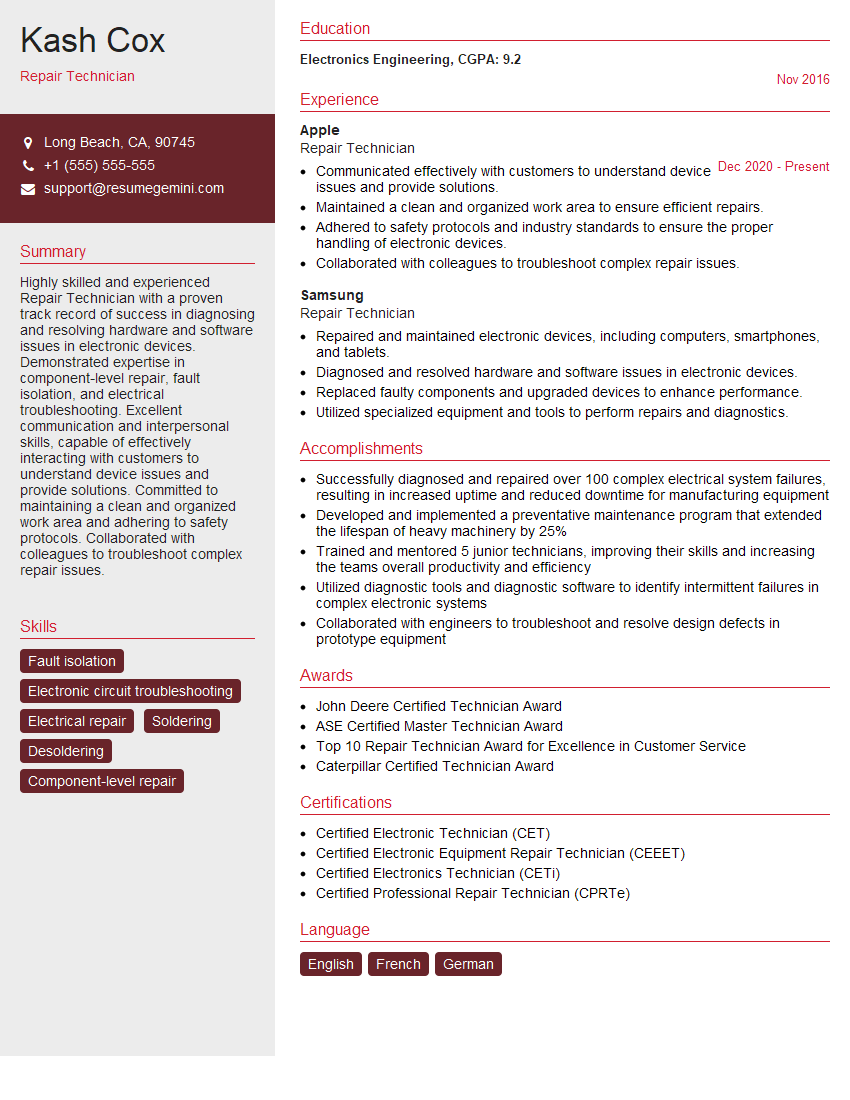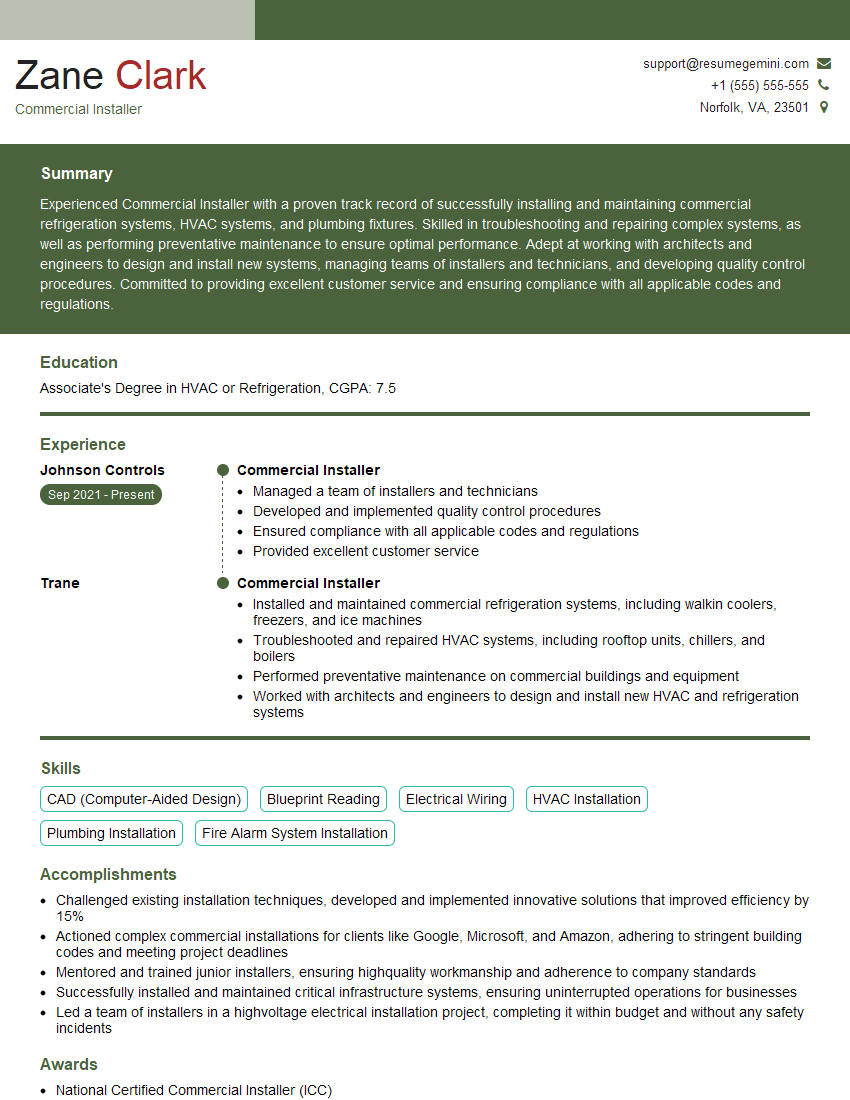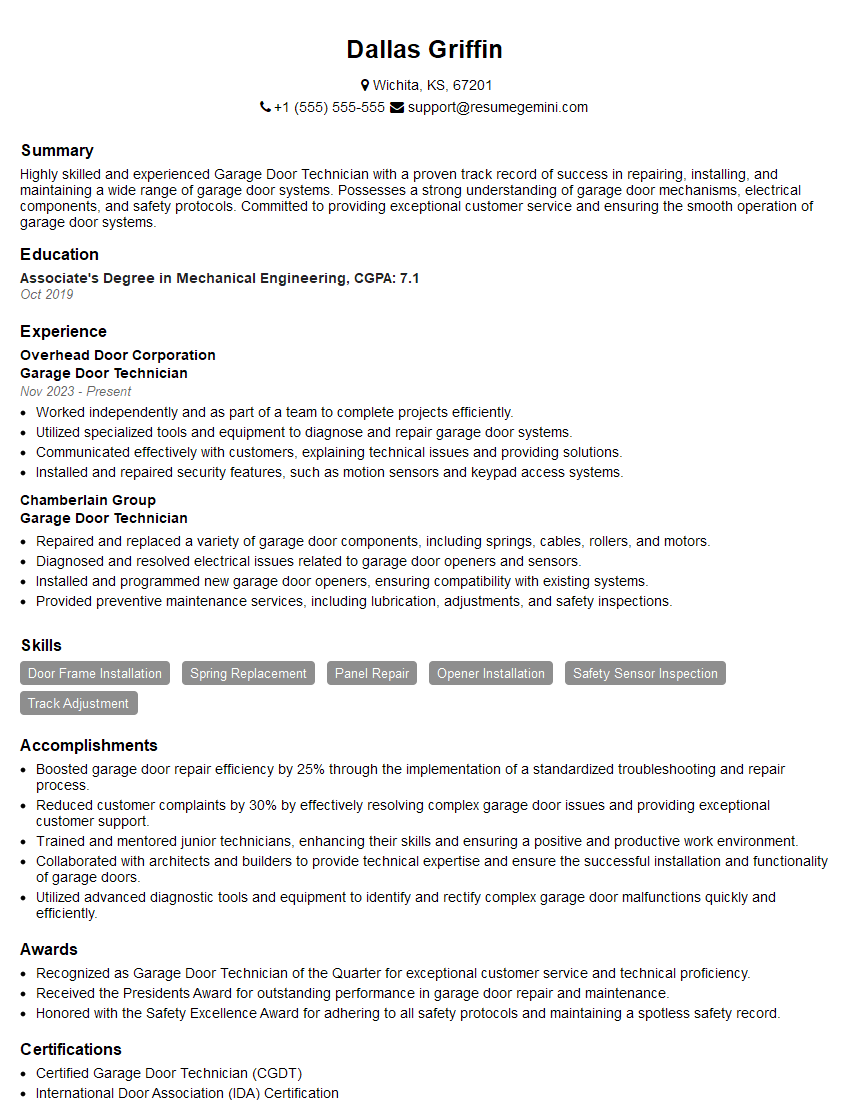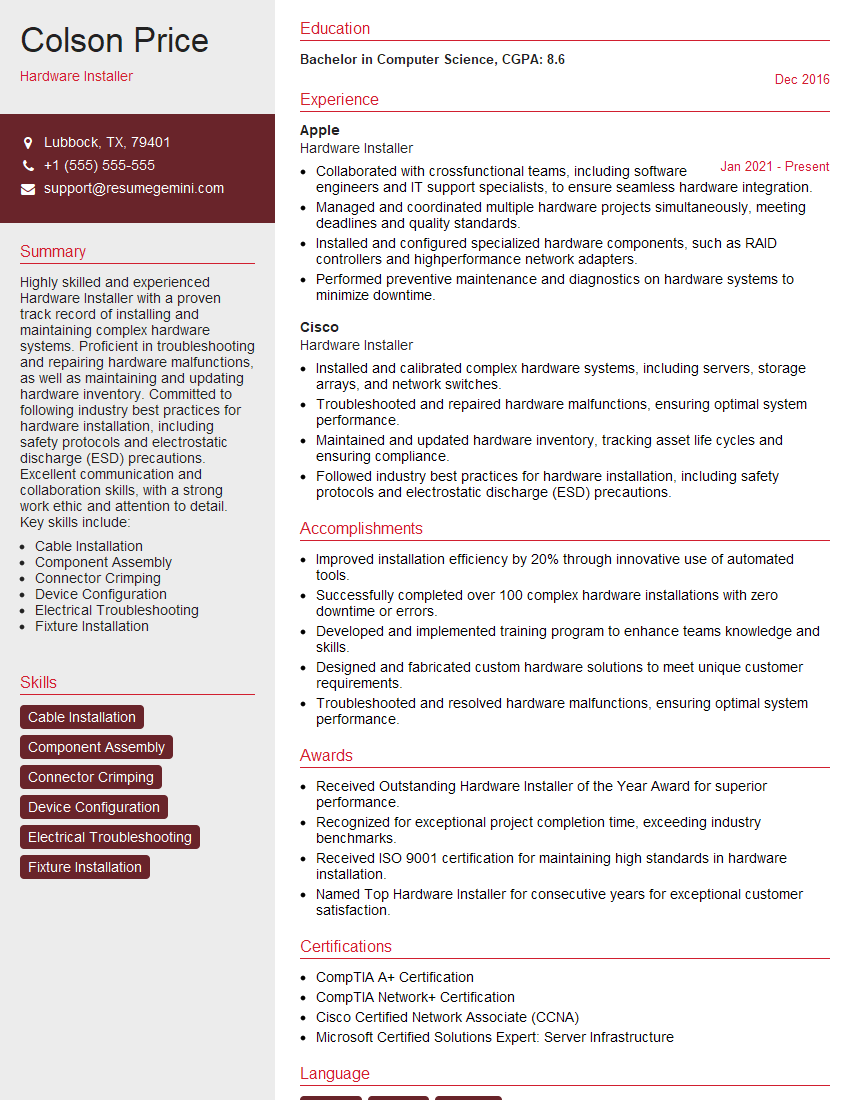Unlock your full potential by mastering the most common Garage Door Keypad Installation interview questions. This blog offers a deep dive into the critical topics, ensuring you’re not only prepared to answer but to excel. With these insights, you’ll approach your interview with clarity and confidence.
Questions Asked in Garage Door Keypad Installation Interview
Q 1. What types of garage door keypad systems are you familiar with?
I’m familiar with a wide range of garage door keypad systems, from basic wired keypads to more advanced wireless and keyless entry systems. These systems vary by brand (like LiftMaster, Chamberlain, Genie, etc.), features (e.g., rolling code technology for enhanced security, backlit keypads for nighttime visibility), and communication protocols (wired, wireless using radio frequency, or even Bluetooth/Wi-Fi enabled smart keypads).
- Wired Keypads: These are directly connected to the garage door opener’s control board via wires, offering reliable performance but limiting placement options.
- Wireless Keypads: These use radio frequencies to communicate with the opener, offering flexibility in placement but requiring battery changes and potential interference issues.
- Keyless Entry Systems: Often using a keypad in conjunction with a remote control or smartphone app, these integrate advanced features such as security codes, access control, and potentially integration with smart home systems.
Understanding the nuances of each type allows me to select the most appropriate system for a client’s needs and existing infrastructure.
Q 2. Explain the process of installing a new keypad on a LiftMaster garage door opener.
Installing a LiftMaster keypad involves several key steps. First, you need to identify the correct wiring and locate the connection points on the garage door opener’s control board. LiftMaster openers usually have clearly labeled terminals for keypad connection. Safety is paramount; always disconnect the power to the opener before starting any wiring work. Next, carefully connect the wires from the keypad to the opener according to the wiring diagram provided with the keypad. The diagram will show which wire goes to which terminal (e.g., common, positive, negative). Once the wiring is complete, carefully tuck the wires away to avoid pinching or damage. Finally, you program the keypad following the opener’s instructions, often involving holding down a button on the opener’s control board and inputting a PIN or entering the programming mode, then following the prompts from there to add and store the new code.
For example, some LiftMaster models require pressing and holding the ‘learn’ button while entering the desired PIN on the keypad. Always refer to the specific instructions provided with your LiftMaster garage door opener and keypad model.
Q 3. How do you troubleshoot a malfunctioning garage door keypad?
Troubleshooting a malfunctioning keypad starts with a methodical approach. First, check the keypad’s batteries (if wireless) or the wiring connections (if wired). A dead battery or a loose connection is a very common cause of failure. Next, test the keypad’s functionality by trying different buttons and codes. If the problem persists, I’d examine the opener’s control board for any signs of damage or loose connections. If the problem seems to be electrical, always double check the power supply and circuit breaker. If still non-functional, the keypad itself could be faulty and may require replacement.
For example, if the keypad only works intermittently, I’d suspect an issue with the radio frequency signal (if wireless) or a poor connection in the wiring (if wired). I might try temporarily moving the keypad closer to the opener to rule out signal interference. Sometimes, a reset of the opener control board might resolve the issue.
Q 4. What are the common causes of keypad failure?
Common causes of keypad failure include:
- Low or dead batteries: This is the most frequent reason for wireless keypads to malfunction.
- Loose or damaged wiring: This is common for wired keypads, especially if exposed to the elements.
- Faulty keypad circuitry: Over time, internal components can wear out or be damaged by moisture.
- Signal interference: Wireless keypads can be susceptible to interference from other devices using the same frequency.
- Improper programming: Incorrectly programmed codes can lead to keypad malfunction.
- Extreme temperatures: Exposure to extreme heat or cold can negatively impact the keypad’s electronics.
Identifying the root cause is crucial for effective repair or replacement.
Q 5. Describe the different types of keypads available (keypad, keyless entry, etc.)
Keypad systems for garage doors offer various options:
- Standard Keypads: These are the most basic type, typically using a numeric keypad to enter a code.
- Keyless Entry Systems: These often involve a keypad combined with a remote control or smartphone app for increased convenience and security. Some use rolling code technology, where the code changes with each use.
- Smart Keypads: These integrate with smart home systems, allowing control through apps and often providing additional features like remote monitoring and security notifications.
- Combination Keypads:Some offer a combination of keypad entry and a physical key entry for added backup.
The choice depends on the user’s budget and desired level of functionality and security.
Q 6. How do you program a new keypad to a garage door opener?
Programming a new keypad varies depending on the brand and model of the garage door opener. However, the general process involves putting the opener into programming mode (usually by pressing and holding a specific button on the opener’s control board), then following the instructions to input the desired code on the keypad. The process often involves confirming the code and sometimes involves pairing the keypad with the opener using a specific sequence of button presses. Always refer to the manual provided with your garage door opener and keypad model.
For instance, some openers use a ‘learn’ button where you input a code on the keypad and then press the learn button on the opener to program the code. Once complete, the opener should save this code in its memory, allowing access through the keypad.
Q 7. How do you handle different wiring configurations during keypad installation?
Different wiring configurations can be encountered during keypad installation. Older openers may have simpler wiring schemes, while newer models might incorporate more advanced features that require additional wiring. It’s crucial to consult the wiring diagram for both the garage door opener and the specific keypad model. This diagram details which wires correspond to the common, positive, and negative terminals. Properly identifying and connecting these wires is essential to prevent damage to the opener or keypad. Pay attention to wire colors and labels to ensure correct connections. In some cases, you may find a different number of wires than expected. This could be due to features like lighting or additional accessories connected to the opener. Double-check that your wiring matches the diagram from your specific opener, and always be certain to turn off the power supply before beginning any wiring.
Incorrect wiring can lead to malfunction, so a careful and methodical approach is key. If unsure, consulting a professional is recommended.
Q 8. What safety precautions do you take during keypad installation?
Safety is paramount during keypad installation. Before starting any work, I always disconnect the power to the garage door opener. This prevents accidental shocks or injuries. I also wear safety glasses to protect my eyes from any debris. Working on a stable ladder or platform is crucial to prevent falls, especially if the keypad is mounted high on the wall. I always keep the work area clear and organized to minimize tripping hazards. Finally, I make sure the area is well-lit to enhance visibility and precision. Think of it like this: you wouldn’t attempt brain surgery without proper precautions; garage door keypad installation, while simpler, still demands a respectful approach to safety.
Q 9. What tools and equipment are essential for keypad installation?
The tools needed for keypad installation are fairly straightforward but crucial for a clean and efficient job. Essential tools include a screwdriver (both Phillips and flathead, depending on the keypad model), a drill with appropriate drill bits (if mounting requires drilling holes), a level to ensure proper alignment, wire strippers/cutters (if wiring is involved), and electrical tape (for securing wires). Sometimes a voltage tester is helpful to double-check power is off before proceeding. I also carry a stud finder to ensure the keypad is mounted securely to a wall stud for maximum strength and longevity. It’s always best to have extra batteries on hand, too, to test the keypad immediately after installation.
Q 10. How do you ensure the keypad is securely mounted?
Secure mounting is vital for both the keypad’s functionality and its security. I always start by locating a wall stud using a stud finder. Mounting directly to a stud provides superior strength and prevents the keypad from being easily ripped off. If a stud isn’t readily available, I use heavy-duty anchors specifically designed for the wall material (drywall, brick, etc.). I use a level to ensure the keypad is perfectly aligned, both vertically and horizontally, for a professional look and to prevent operational issues. Once the mounting screws are in, I firmly tighten them to secure the keypad in place but avoid over-tightening, which can damage the keypad or wall. A securely mounted keypad is less vulnerable to tampering or accidental damage. It’s like building a house: a strong foundation is essential.
Q 11. Explain the process of replacing a damaged keypad.
Replacing a damaged keypad is relatively straightforward, but always remember to disconnect power first! The process typically involves removing the old keypad by unscrewing it from the wall. Then, carefully remove any wires connected to the old keypad, noting their position and color coding. This is where clear labeling is essential. Next, mount the new keypad using the same procedure as a new installation (stud finder, level, etc.). Reconnect the wires, making sure they match the color coding of the old keypad. Finally, test the new keypad’s functionality (more on that in the next answer). Treat each step with care – rushing can lead to incorrect wiring and potential damage.
Q 12. How do you test the functionality of a newly installed keypad?
Testing the new keypad’s functionality is the final, crucial step. First, reconnect the power to the garage door opener. Then, carefully enter the programmed code to activate the garage door. Check if the door opens and closes smoothly without any hiccups. Test the keypad several times to ensure consistent operation. Furthermore, I test the range of the keypad, moving away to see how far the signal is detected. It’s a simple process, but it guarantees satisfaction and confirms a well-done job. If there are issues, carefully retrace the steps, checking wiring and connections.
Q 13. What are the common security vulnerabilities associated with garage door keypads?
Common security vulnerabilities associated with garage door keypads include easily guessable codes (like repeated numbers or birthdays), easily visible codes from a distance, and the potential for radio frequency (RF) signal interception by malicious actors. Older keypads might have weaker encryption than newer models, making them more susceptible to hacking. Another vulnerability stems from simple physical access – if someone can get close enough, they may be able to see the code as it’s being entered. These vulnerabilities highlight the need for choosing secure keypads, using strong codes, and potentially incorporating additional security measures.
Q 14. How do you address customer concerns regarding keypad security?
Addressing customer concerns about keypad security is key to building trust. I start by explaining the vulnerabilities and how to mitigate them. This often involves recommending a keypad with stronger encryption, suggesting the use of complex, randomly generated codes, or advising on the importance of regular code changes. I also explain the benefits of using additional security measures like smart home integration with features like alerts for unauthorized access. Open communication and providing clear solutions that address their specific concerns are essential. Building trust is paramount – it’s not just about installing a keypad; it’s about securing their home and belongings.
Q 15. Describe your experience with different brands of garage door openers.
Over my decade-long career, I’ve worked extensively with a wide range of garage door opener brands, including Chamberlain, LiftMaster, Genie, and Craftsman. Each brand has its own nuances in terms of programming protocols and keypad compatibility. For example, Chamberlain and LiftMaster openers often share similar programming methods, utilizing a series of button presses on the opener itself. However, Genie openers might require a slightly different approach, sometimes involving DIP switches or specific sequences on the keypad itself. Understanding these differences is crucial for efficient and successful installations.
My experience extends beyond just recognizing the brands; I deeply understand their internal workings. This allows me to quickly diagnose issues even when presented with an unfamiliar model. I’ve learned to adapt my installation techniques to account for variations in wiring, connector types, and programming logic across various brands. For instance, some brands prioritize wireless connectivity, while others rely on more traditional hardwired connections. My familiarity encompasses this entire spectrum.
Career Expert Tips:
- Ace those interviews! Prepare effectively by reviewing the Top 50 Most Common Interview Questions on ResumeGemini.
- Navigate your job search with confidence! Explore a wide range of Career Tips on ResumeGemini. Learn about common challenges and recommendations to overcome them.
- Craft the perfect resume! Master the Art of Resume Writing with ResumeGemini’s guide. Showcase your unique qualifications and achievements effectively.
- Don’t miss out on holiday savings! Build your dream resume with ResumeGemini’s ATS optimized templates.
Q 16. How do you handle situations where the keypad is not compatible with the opener?
Incompatibility between keypads and openers is a common challenge. It usually arises from using a keypad designed for a different opener brand or model. My first step is to carefully identify both the opener model and the keypad model. This information is usually found on the devices themselves or in their respective manuals. Once identified, I cross-reference them against a compatibility chart (many manufacturers provide these online). If incompatibility is confirmed, several options exist.
The most straightforward solution is to replace the keypad with a compatible model. If the client is keen on keeping the existing keypad, we might explore using a universal keypad, provided it’s compatible with the opener’s receiving system. Sometimes, a simple firmware update on the opener (if possible) might resolve the issue. However, in more complex scenarios, it might require a complete replacement of the opener itself—a less desirable but sometimes necessary solution. Throughout this process, clear and transparent communication with the client is paramount.
Q 17. What is your experience with troubleshooting keypad programming issues?
Troubleshooting keypad programming problems involves a systematic approach. I start by verifying power to the keypad and opener. A simple visual inspection often reveals loose wires or blown fuses. Next, I confirm correct wiring, matching the keypad wires to the corresponding terminals on the opener. Sometimes, a simple reconnection resolves the problem. Incorrect wiring can lead to erratic behavior or complete failure to program.
If wiring is correct, I then meticulously review the programming instructions specific to that opener and keypad model. Many times, errors are due to simple human error – an incorrect button press or a missed step. I often walk clients through the process again, ensuring every step is done precisely. Sometimes, clearing the keypad’s memory and starting the programming from scratch is needed. More advanced troubleshooting may involve using a multimeter to test the signal between the keypad and opener to pinpoint any signal faults. Ultimately, my goal is to solve the problem with the least disruptive intervention possible.
Q 18. How do you determine the appropriate keypad for a specific application?
Choosing the right keypad hinges on several factors. First, the opener’s brand and model are critical – compatibility is paramount. Next, I consider the client’s needs and preferences. Do they need a wired or wireless keypad? A wireless keypad offers convenience but is susceptible to battery depletion and interference. Wired keypads are generally more reliable but might require more complex installation.
The location of installation plays a key role. Exterior installations call for weatherproof keypads with robust construction to withstand the elements. A keypad’s aesthetic appeal often matters; I’d offer options that blend seamlessly with the garage door’s design and surroundings. Security also plays a part. Keypads with advanced encryption methods offer better protection against unauthorized access. In short, choosing the right keypad is a balanced consideration of technical specifications, client needs, and environmental factors.
Q 19. Explain the difference between hardwired and wireless keypads.
The core difference lies in their connection to the garage door opener. A hardwired keypad connects directly to the opener via wires. This typically provides a more reliable and consistent signal, reducing the risk of interference or signal dropout. Installation might be slightly more involved due to the wiring required. However, once installed, it is typically more reliable than a wireless counterpart.
A wireless keypad communicates with the opener via radio frequency signals. It eliminates the need for wiring, providing more flexibility in placement. However, it relies on batteries and is susceptible to interference from other wireless devices, potentially leading to range issues or intermittent functionality. For many customers, this wireless convenience outweighs the reliability of the hardwired keypad.
Q 20. How do you ensure proper functionality of the keypad after installation?
Post-installation, thorough testing is essential. I begin by verifying the keypad’s response to button presses. Does each button function correctly? Does the opener respond promptly and consistently? I test both opening and closing functionalities, confirming their reliability and speed. If the keypad is wireless, I evaluate its range, checking its functionality at various distances from the opener.
I also demonstrate the functionality to the client, explaining the operating procedure and answering any questions. Finally, I check for any potential safety hazards, such as exposed wires or loose components. This rigorous testing ensures a smooth, safe, and reliable operation for the client. Post-installation troubleshooting can be reduced by this careful post-installation verification of functionality. A follow-up phone call a week later ensures customer satisfaction and addresses any potential issues that may have arisen since the initial installation.
Q 21. What are the advantages and disadvantages of different keypad types?
Different keypad types offer various advantages and disadvantages. For example, wired keypads are generally more reliable due to their direct connection, making them less prone to interference. However, they lack the flexibility of wireless keypads in terms of placement. They also require more installation effort.
Wireless keypads offer superior placement flexibility, letting you mount them almost anywhere within range. They are also generally easier to install. The downsides are battery life (requiring periodic replacement) and susceptibility to interference, potentially leading to intermittent functionality. Keyless entry systems provide enhanced security via pin codes, but their complexity might outweigh the benefits for some users. The choice depends on prioritizing reliability, convenience, and security.
Q 22. What is your experience with troubleshooting power issues related to keypads?
Troubleshooting power issues with garage door keypads often involves a systematic approach. First, I’d verify the keypad’s power source. This might involve checking the batteries (if it’s battery-powered) for sufficient charge or proper connection. For wired keypads, I’d inspect the wiring connections at both the keypad and the garage door opener, looking for loose wires or damage. A multimeter can be invaluable here to check voltage and continuity.
Sometimes, the problem isn’t directly with the keypad itself but with the opener’s power supply. I’d then check the power supply to the opener, ensuring it’s receiving the correct voltage and there are no blown fuses or tripped circuit breakers. If the problem persists after checking the obvious, I might need to trace the wiring further back to the power source, looking for potential breaks or shorts in the wiring. I always prioritize safety and disconnect the power before handling any wiring.
For example, I once encountered a keypad that appeared completely dead. After checking the batteries, I found the issue was actually a corroded connection at the battery terminal. A simple cleaning with a wire brush resolved the problem.
Q 23. How do you handle customer requests for additional features or upgrades?
Handling customer requests for additional features or upgrades is about careful communication and understanding their needs. I start by actively listening to their requests, ensuring I completely understand what they’re looking for. This might involve adding extra keypads, upgrading to a keypad with more advanced features like keyless entry or integration with smart home systems, or even adding a different type of access control, such as a fingerprint scanner.
I then discuss the feasibility and cost implications of their request. Some upgrades might be simple and straightforward, while others could require significant rewiring or the replacement of the entire garage door opener system. I provide them with a clear breakdown of the work involved, the associated costs, and the estimated timeframe for completion. Transparency is key; I always aim to set realistic expectations.
For instance, a customer might request integration with their smart home system. I would assess their current system’s capabilities and determine if it’s compatible with the existing opener or if an upgrade is needed. This could involve adding a compatible module or even suggesting a complete smart garage door opener replacement.
Q 24. What is your process for documenting keypad installation and configuration?
My documentation process for keypad installation and configuration is meticulous and follows a standardized format. I begin by creating a detailed job sheet that includes the customer’s information, the date of installation, the model number of the keypad and opener, and a brief description of the work performed. This is followed by a photographic record of the entire installation process, from the initial wiring to the final testing.
The configuration details are also meticulously documented, including the programming of access codes, any specific settings implemented (such as auto-close timers), and a final test report confirming that the system is functioning correctly. I also include any troubleshooting steps undertaken during the installation or any special considerations related to the particular installation environment. All documentation is stored digitally and physically for easy retrieval and future reference.
This systematic approach ensures that any future issues can be easily addressed, and it provides a clear history of the installation for both the customer and myself. It also helps in identifying trends or common issues that might require further investigation.
Q 25. How do you stay up-to-date on the latest technology and best practices for keypad installation?
Staying current in this field requires continuous learning. I achieve this through several methods. I actively participate in industry-specific webinars and workshops, attending conferences, and reading trade publications. Manufacturer websites are invaluable resources, providing up-to-date information on new products, features, and installation techniques. I also regularly connect with colleagues and other professionals in the field, sharing best practices and learning from their experiences.
Moreover, I actively monitor online forums and communities related to garage door repair and installation. This allows me to identify emerging trends, troubleshooting techniques for novel issues, and engage in discussions with other experts. Continuous learning is vital for offering clients the best service and ensuring I’m using the most effective and safe methods.
Q 26. Explain your experience with different types of access control systems.
My experience encompasses a range of access control systems beyond basic keypads. I’ve worked with keyless entry systems using keypads with rolling codes for enhanced security, systems integrating with smartphone apps for remote access and control, and more sophisticated systems using biometric authentication such as fingerprint scanners. I’ve also installed systems that integrate with home security systems, allowing for centralized control and monitoring.
Each system has its own strengths and weaknesses, and my approach is to assess the customer’s specific needs and security concerns before recommending a particular system. For instance, a high-security residential setting might benefit from a system with rolling codes and potentially a secondary authentication method, while a simpler application like a secondary access point for a workshop might only need a basic keypad.
Q 27. Describe a time you had to troubleshoot a complex keypad problem. What was your approach?
I recall an instance where a keypad was intermittently malfunctioning – sometimes it would work, other times it wouldn’t respond at all. My initial troubleshooting steps included checking the power source, verifying the wiring connections, and testing the batteries (it was a battery-powered unit). These checks yielded no obvious problems. I then carefully examined the keypad itself, suspecting a possible internal fault.
My approach involved a methodical process of elimination. I systematically checked the circuit board, looking for any visible signs of damage or loose components. I used a multimeter to test the voltage across various points on the board to identify any anomalies. I found a slightly loose solder joint on one of the integrated circuits. After resoldering the connection, the keypad functioned perfectly. This highlighted the importance of a thorough examination and the value of understanding basic electronics.
Q 28. How do you ensure that the installation meets all safety codes and regulations?
Ensuring installation meets safety codes and regulations is paramount. I adhere to all relevant local, state, and national electrical codes. This includes proper grounding, using appropriately rated wiring, and ensuring that all wiring is securely connected and properly protected. I also make sure the installation doesn’t obstruct any emergency exits or create tripping hazards. Before starting any work, I confirm the location is safe and free of potential hazards.
Safety is a top priority. I always disconnect the power supply to the opener before performing any wiring or component replacement. I use appropriate personal protective equipment (PPE), including safety glasses and gloves. I also thoroughly test the system after installation to confirm it operates correctly and safely, ensuring there are no shorts or other safety concerns. My focus is always on providing a functional and safe installation that meets all necessary regulations.
Key Topics to Learn for Garage Door Keypad Installation Interview
- Understanding Keypad Types and Functionality: Familiarize yourself with different keypad types (keypad, keyless entry, etc.), their features, and how they integrate with various garage door opener systems.
- Installation Procedures: Master the step-by-step process of installing various keypad models, including wiring diagrams, proper placement, and testing functionality.
- Troubleshooting Common Issues: Learn to diagnose and resolve common problems like incorrect programming, faulty wiring, low battery indicators, and connectivity issues.
- Safety Protocols: Understand and adhere to all safety regulations during installation and troubleshooting, including working with electrical components and heights.
- Code Setting and Programming: Become proficient in setting and changing access codes, understanding different programming methods, and addressing user access management.
- Compatibility and Integration: Learn about compatibility between different keypad models and garage door opener brands. Understand the nuances of integration with smart home systems.
- Customer Service and Communication: Practice clear and concise communication with customers regarding installation procedures, troubleshooting, and addressing their concerns.
- Maintaining Professionalism: Understand the importance of presenting yourself as a knowledgeable, professional, and reliable technician.
Next Steps
Mastering Garage Door Keypad Installation opens doors to exciting career opportunities in the home services industry. This skill is highly sought after, offering excellent prospects for growth and advancement. To maximize your job search success, it’s crucial to create an ATS-friendly resume that highlights your skills and experience effectively. We strongly encourage you to leverage ResumeGemini, a trusted resource for building professional and impactful resumes. ResumeGemini provides examples of resumes tailored to Garage Door Keypad Installation, ensuring your application stands out from the competition. Take the next step towards your dream job today!
Explore more articles
Users Rating of Our Blogs
Share Your Experience
We value your feedback! Please rate our content and share your thoughts (optional).
What Readers Say About Our Blog
Interesting Article, I liked the depth of knowledge you’ve shared.
Helpful, thanks for sharing.
Hi, I represent a social media marketing agency and liked your blog
Hi, I represent an SEO company that specialises in getting you AI citations and higher rankings on Google. I’d like to offer you a 100% free SEO audit for your website. Would you be interested?





